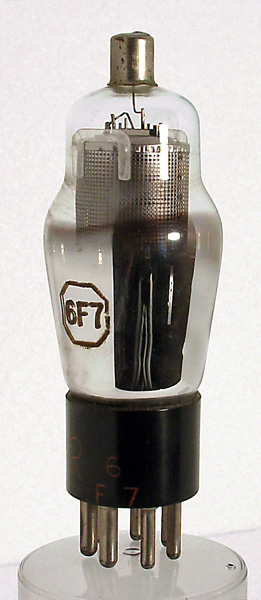|
6F7Sensibly equivalent¶ to:CV1915
|
|
|

|
The 6F7 is a triode pentode frequency changer. It was the 6.3V version of the 2.5V type 2F7. We believe that they were the first such types to hit the market, the 2F7 dating back to the early 1930s. The later 6P7G is the same valve but fitted onto an octal base.Previous frequency changers had either been heptodes (pentagrid converters) or mixers requiring a separate oscillator valve. Early self-oscillating frequency converters were notorious for 'pulling' (shifting frequency in response to the station being received) and, since the ill-effects of pulling increase in proportion to signal frequency, it is unlikely that these valves would have been much use at 30 MHz (The top end of the short wave bands).It was the invention of the triode-hexode (Telefunken, Germany in around 1933/4) and its subsequent systematic development in the US and elsewhere which opened the way to using low-cost superhet domestic receivers on short waves. Even so, there was little activity above 23 MHz (13 metre band) until the advent of TV and radar during the late 1930s and early 1940s.The classic envelope is 36 mm in diameter and, excluding the UX7 base pins, is 97 mm tall.References: Data-sheet, Data, 1040 & 1043. Type 6F7 was first introduced in 1936. See also 1936 adverts. |
Pin Connections
| 1 | 2 | 3 | 4 | 5 | 6 | 7 | tc |  h | a | g2 | a(t) | g1(t) | k | h | g1 |
|
|
Absolute Maximum Operating Conditions¶
| Vh | Ah | Va | Vs | Vg | mAa | mAs | ra | gm | 
| 6.3 | 0.3 | 250 | 100 | -3 | 2.8 | 0.6 | 2.0M | 0.3 |
|
Updated January 21, 2023.
|
|